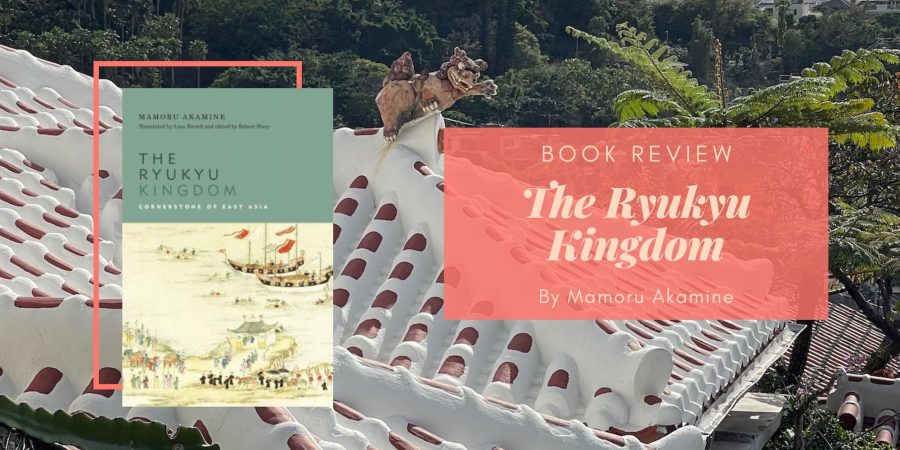When it comes to books on the history of Okinawa, I haven’t been able to find much in English. Most of the books I can see cover the battle of Okinawa, or they talk about Okinawa’s diet or karate traditions. So in this way, The Ryukyu Kingdom fills an important void because who doesn’t want to know more about a place they’ve been to?
Translated from Japanese, The Ryukyu Kingdom paints a picture of a kingdom – well actually three kingdoms – as it maintains its autonomy by submitting to two greater powers in the region: China and Japan. Originally three autonomous regions known as the Sanzan (the “Three Mountains” or “Three Mountain Kingdoms”, the Kingdom of Ryukyu was unified in 1429 with the first Sho dynasty. However even before that, the most powerful of the three factions, Chuzan, had already been recognised as a vassal state of Ming-dynasty China in 1372. Around the time of the 16th century, Ryukyu is conquered by the Satsuma under the Japanese Bakufu and thus it begins a process of sinification in order to keep its identity distinct from Japan.
And thus Mamoru Akamine brings us through the tightrope that the Ryukyu kingdom walked for centuries. This was what the royal Ryukyu court called its “great challenge”, where its existence depended on being able to balance the interests of two outside nations. As Akamine writes:
“Ryukyu’s sense of sovereignty was born from this great challenge diplomacy, which itself stemmed from the dual-identity polity, which held Ryukyu to be a vassal of China and a vassal of Japan. And because any slipup in the execution of this great challenge diplomacy would greatly impact the kingdom’s continued existence, the ruling members of the royal government always imbued the challenge with great meaning.”
Because of this focus, the book doesn’t talk much about the internal politics of the Ryukyu Kingdom. We get a good understanding of how their court worked and what were the various ranks, but I didn’t get any sense of the various factions within the courts or between the three kingdoms in the Ryukyu. In a way, the political emphasis is on the relationships between Ryukyu and other nations rather than within Ryukyu itself. If you’re looking for a book that focuses more on the internal history of the Ryukyu kingdom, this may not be what you’re looking for.
This isn’t to say that the book focuses only on the larger political movements. Akamine goes into detail on the rituals involved in trade and tribute missions, along with very interesting descriptions of how the ships looked and what the various flags were for. I didn’t realise that there would be a centipede flag among all the others because the centipede was said to be able to intimidate malicious sea deities and ensure good weather.
As this is my second time reading the book and because I actually took notes the first time I read this in 2019 (I thought I saw a book review but I can’t find it anymore), I could sort of compare what caught my eye this time round. In general, the things that I would have noted down remain the same but I did realise that the theme of finding an identity by balancing between two cultures resonated a lot more strongly now than it did before. And perhaps also because I’ve also been more interested in hanfu and women’s stories in general, I immediately noticed this passing reference to a woman who sounds like she has a story to tell. In Chapter 1, the book writes that a settlement of traders gathered around a merchant named Wang Sheng [J. O Sho] whose Japanese wife gained notoriety. That’s all it says but the footnotes have a bit more information: In 1511, the widow of Wang Sheng was named in an arrest warrant and rounded up along with many others in a raid on Sung merchants ordered by Dazaifu Deputy governor Muneyori. Some historians believe she was Japanese but not all accounts say so and I am intrigued! What was her name? Why was she singled out? Was she the reason why the traders gathered around Wang Sheng? What was it like to be living in that time period? I want to know but I’m not sure where to start.
Overall, if you’ve got an interest in Okinawan history or just Asian history in general, The Ryukyu Kingdom is worth picking up. Not only does it give a good history of the Ryukyu Kingdom via its relationships with external powers, it also gives the reader an understanding of how interconnected the region has always been and how this “great challenge” of diplomacy is one that is still relevant today.

I know nothing about East Asian history. This sounds interesting. Amazing review!
This one is very interesting – I haven’t seen much about Okinawa so it fills a niche!
This sounds like such an intriguing read!
It was! Okinawa’s history is so fascinating, I’m glad I learnt more about it